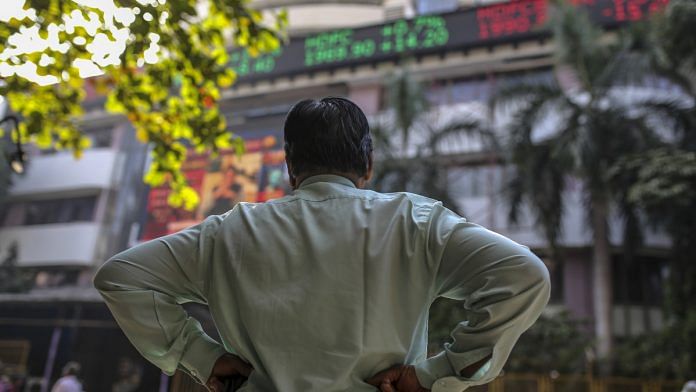Mumbai/Sydney: India’s economy may be faltering, but its $2.1 trillion stock market has been powering to new highs as foreign investors pile into country’s shares, betting the worst may have already passed.
Economic growth is at the lowest since before Prime Minister Narendra Modi came to power in 2014. The economy expanded 4.5% in July-September, slowing for a sixth straight quarter as deteriorating local consumption, troubled banks and a weak global outlook all took their toll.
But the equity market? Now, that’s a different story. The S&P BSE Sensex Index surged 13% from a low on Sept. 19 as it rose to all-time highs. Foreigners purchased a net $5 billion, give or take, of the country’s shares so far this quarter, while domestic investors have remained buyers of equity funds.
The bull case is that nothing here is out of whack. Stocks are simply acting as a leading indicator for the economy.
“Growth has likely bottomed out,” Timothy Moe, chief Asia Pacific regional equity strategist at Goldman Sachs Group Inc., said in Mumbai Tuesday. “We see it as one of the top three Asian markets for earnings growth next year.”
Moe said he expects profit growth to recover from 12% this year to 16% in 2020. That’s his best earnings forecast for a country in the region next year after South Korea.
And there have been signs Asia’s third-largest economy may be about to turn around. Surveys for manufacturing and services in November, for instance, both pointed to a rebound.
Modi himself has been taking steps to revive growth from a six-year low. In September, he slashed the corporate tax rate. He’s also eased foreign investment rules in retail, manufacturing and coal mining, merged 10 state-run banks to create four big lenders, and announced a $1.4 billion fund to salvage stalled real estate projects.
Then there’s the Reserve Bank of India, which has cut interest rates five times this year, even though it refrained from a sixth reduction on Thursday.
Investors expect both the government and the RBI to follow up with more measures.
“There are expectations around the budget for some cuts in personal taxes, which is required to spur consumption,” said Shyamsunder Bhat, chief investment officer of Exide Life Insurance Co. in Mumbai. The government must spend even if it means slipping on the deficit target for this fiscal year, he said.
To be sure, the Sensex’s advance is being driven by only a handful of stocks, a sign of its potential fragility. Two, in particular, Reliance Industries Ltd. and ICICI Bank Ltd., account for about half the measure’s gain. Some 14 of the gauge’s 31 members, or about 45%, have posted declines this year.
But it’s not as if India’s 13% rally this year is that different from what’s happening elsewhere in the world. Many stock markets have had double-digit percentage increases even as economic fundamentals weaken. A global benchmark of developing and emerging-market equities is trading just below an all-time high despite concerns over global growth and the trade war between the U.S. and China.
“With low global interest rates, asset prices are getting a lift — not just in India,” Raymond Lee, a Sydney-based fund manager who helps manage the equivalent of $10 billion at Kapstream Capital, said on Bloomberg TV on Thursday.
Not everyone is convinced the economy will turn a corner just because the stock market did, or that shares will continue to climb.
Economic recovery may take longer to set in, Credit Suisse Group AG wrote in a note last week. BNP Paribas SA, on Nov. 25 called time on the index rally, saying there’s unlikely to be a significant uptick in economic data in the near term.
Adding to the bear case, the Sensex is trading above 19 times 12-month blended forward earnings, close to a level that’s proved the ceiling for gains in the past few years. And short interest remains high in the $5.4 billion iShares MSCI India exchange-traded fund, which tracks Indian shares in New York.
But for now at least, some equity investors are unfazed by the weak economic data — and expect the situation to get better.
“While growth hasn’t quite bottomed yet, India’s policy response is beginning to take shape,” Mixo Das, a strategist at JPMorgan Chase & Co., wrote in a report last month. “India looks set to be the turnaround story of early 2020.” – Bloomberg
Also read:







Typical Media pump up Bullshit. Stock market is going or gone no where since the 2nf term election of media darling.